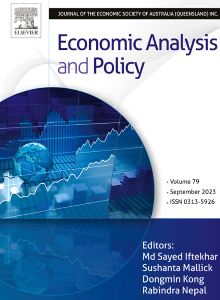Epidemic shocks, structural monetary policy and SME financing in China
IF 8.7
2区 经济学
Q1 ECONOMICS
引用次数: 0
Abstract
This paper extends the SIR-DSGE framework developed in Eichenbaum et al. (2021, 2022) to study the impacts of structural monetary policy—targeted central bank instruments designed to channel credit to specific sectors or markets, in response to epidemic shocks on SME financing. The model distinguishes between large enterprises (LEs) and SMEs by their labor intensity in production and working capital constraints, and incorporates four commonly used structural policy tools in China. Structural monetary policy tools take effects by incentivizing banks to offer financing support to SMEs. Results show that SMEs are more severely hit by the epidemic for their high labor-intensity in production and tighter working capital constraints, and structural monetary policy can mitigate the severity of an epidemic shock on the macroeconomy and SMEs, by lowering financing costs and increasing financing availability for SMEs. Whether for the economy as a whole or SMEs, structural monetary policy tools yields better stabilization effects than conventional monetary policy. Further analysis shows that the combination of structural and conventional monetary policy improves social welfare than with conventional monetary policy alone, and price-based structural monetary policy instruments are more desirable than quantity-based.
流行病冲击、结构性货币政策与中国中小企业融资
本文扩展了Eichenbaum等人(2021,2022)开发的SIR-DSGE框架,以研究以结构性货币政策为目标的央行工具的影响,这些工具旨在将信贷引导到特定部门或市场,以应对对中小企业融资的流行病冲击。该模型根据生产中的劳动强度和营运资金约束对大型企业和中小企业进行了区分,并结合了中国常用的四种结构性政策工具。结构性货币政策工具通过激励银行向中小企业提供融资支持来发挥作用。结果表明,中小企业生产劳动强度高,营运资金约束偏紧,受疫情冲击更严重,结构性货币政策可以通过降低融资成本和增加中小企业融资可得性来减轻疫情对宏观经济和中小企业冲击的严重程度。无论是对整体经济还是对中小企业,结构性货币政策工具都比常规货币政策具有更好的稳定效果。进一步的分析表明,与单独使用常规货币政策相比,结构性货币政策和常规货币政策相结合可以改善社会福利,并且基于价格的结构性货币政策工具比基于数量的结构性货币政策工具更可取。
本文章由计算机程序翻译,如有差异,请以英文原文为准。
求助全文
约1分钟内获得全文
求助全文
来源期刊

Economic Analysis and Policy
ECONOMICS-
CiteScore
9.80
自引率
9.20%
发文量
231
审稿时长
93 days
期刊介绍:
Economic Analysis and Policy (established 1970) publishes articles from all branches of economics with a particular focus on research, theoretical and applied, which has strong policy relevance. The journal also publishes survey articles and empirical replications on key policy issues. Authors are expected to highlight the main insights in a non-technical introduction and in the conclusion.
 求助内容:
求助内容: 应助结果提醒方式:
应助结果提醒方式:


